Jump To:
- Market Analysis of Availability in the Spring Portal
- Spring Portal Strategies
- Impact Transfers for This Cycle
The purpose of this article is to shed a light on:
- How schools should set expectations on performance coming out of the spring transfer portal
- How to strategize for the spring portal
Market Analysis of Availability in the Spring Portal
How Spring Portal Differs from Winter
The spring transfer portal is a distinctly different marketplace than its winter counterpart. Whereas the winter portal contains the bulk of player movement and remains the main avenue for programs to upgrade their starting talent, the spring portal offers two distinct modes of talent acquisition:
- The spring portal captures many players who have read the writing on the wall during spring football regarding their status in their current program. This includes an array of players, from younger hopefuls missing out on a starting role to established vets getting crowded out. These “misfits” have the lifeline of the spring portal to try and find a better spot.
- The wake of transfers from coaching changes. As each coaching change re-opens the portal for those affected players, you get a steady trickle throughout the offseason of players declaring. This season, for example, Stanford parted ways with Troy Taylor, resulting in transfers throughout the latter part of March and Early April, including starters David Bailey, Emmett Mosley V, and Jake Maikkula. All three of those players are “atypical” of the spring portal in the sense that absent a coaching change, the three of them were expected to be leading contributors on their early teams.
Spring Portal Premium Positional Scarcity
The composition of the spring transfer portal the last couple of years has been relatively consistent. Focusing on the top 50 recruits to enter in the spring, we see an average of 11 wide receivers, 6 corners, 6 defensive linemen, 5 safeties, 5 inside backers, 4 outside backers, 3 running backs, 3 interior offensive linemen, 2 tackles, 2 tight ends, and 1 quarterback. It should be no surprise that the premium positions of quarterback and tackle see such little volume, as well as tight ends, which are generally a developmental position in college football. Wide receivers, corners, and interior defensive linemen are much more “plug and play” in the sense they can easily move, adapt to new systems, and hop right in to contribute. This leaves players at those positions with much more flexibility to evaluate their fit and role consistently, having the freedom to immediately contribute elsewhere.
2024 Spring Portal Movement Trends
In the 2024 portal, we saw top end players at WR (Sam Brown, KeAndre Lambert-Smith) and RB (Damien Martinez) transfer due to coaching changes. Overall, though, we saw a dramatic reduction in top-end receivers transferring (6 in the spring top 50 relative to 14 the year before), and an increase in running backs (5 in the top 50 relative to 3 the two years before). These trends suggest the prevalence of positional value in college football, as NIL and revenue sharing considerations re-shape the way that teams must confront talent acquisition and retention. Fewer wide receivers suggest better efforts from teams to retain their talent and more proactivity in securing transfers earlier in the cycle. As for running backs, we’re seeing more opportunities for them to find fits after teams have optimized their more pressing positions.
Lack of G5-to-P4 Transfers
Another trend worth monitoring in the spring portal: top end transfers from G5 schools up to the P4 are effectively non-existent. Of the top 50 rated spring portal players last season, one of them came from a non-power school – Youngstown State’s Deamontae Diggs. That stark reality just underscores the purpose the spring portal serves; it primarily allows movement for depth players to pursue a better opportunity and secondarily as an adjustment mechanism for players facing a coaching change.
Spring Portal Strategies
Reviewing Winter Portal Strategies
As mentioned in a previous article, the typical approach for the winter portal is to target high-end performers at lower levels or crowded P4 position room (former “blue chip” recruits stuck on the depth chart). These are both strategies you could employ using the SūmerSports player database. You can look at a myriad of production-based stats from a player’s career as well as look at their player profile to see by season and game. The player database also allows you to filter by a player’s HS recruiting stars and filter by those with low snaps to identify some prospects who would be worthwhile targeting in the transfer portal.
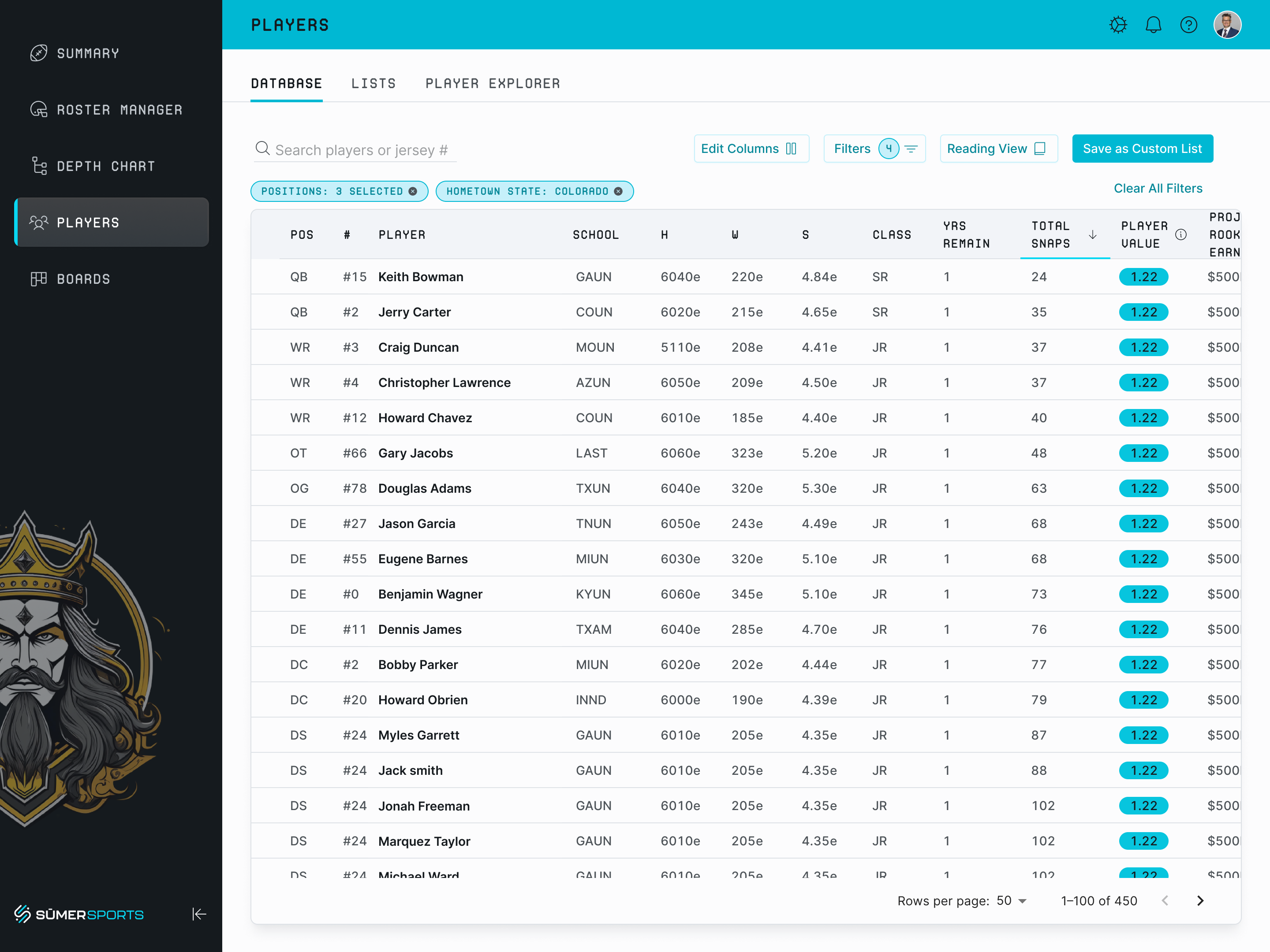
Given this data is live year-round, this gives personnel departments an opportunity to verify by film by using our list function to create target lists in the application. With the help of our AI driven role analytics (customized for each position) as well as continuously updating player value, which boils down a player’s contribution to one number from their starting game to their last, you can see how player performs in each facet of the game.
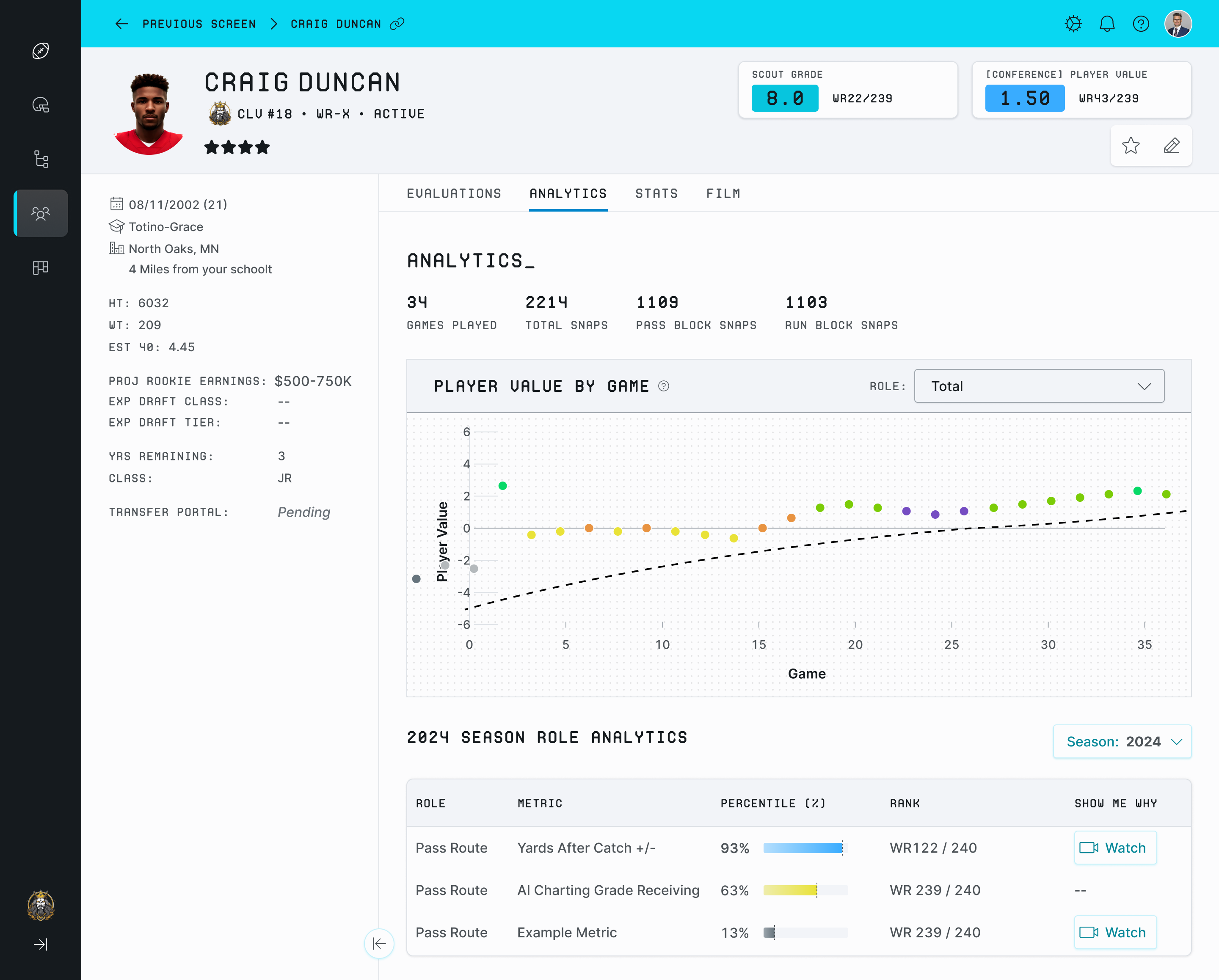
These are all searchable tools to find any player possible in navigating the portal.

The winter portal has the bulk of the premier players with a higher percentage historical of former “blue-chip” recruits in the winter portal than spring portal. The spring portal allows for more creativity with the ultimate goal of building depth. Any uncertainty at a position group from spring practice should give cause to a program looking to add new competition and round out the position group heading into the summer. Most of the spring portal strategy will be looking at coaching changes or identifying players with certain size or athleticism attributes that have entered the portal. There has been a lot of buzz as of late around the spring game being a scouting opportunity for schools as well. The following are additional search strategies to employ when identifying players for the spring portal:
Circle Back on Previous High School Offers
The SumerSports player value metric is predictive of a player’s future ability with the information we have on the player even with limited snaps at the collegiate level. For a former 4-star player stuck on the depth chart, he may have a higher player value metric given the historical signal we have a 4-star performer at the collegiate level and his value is discounted as such. Kicking the tires on previous HS offers, especially with players coaches have existing HS pipeline connection, can be crucial if their initial situation didn’t work out. The expectation on their performance in the future is what is listed in the application to start to circle back to how they like their current situation. A good example of this in the spring portal is Antwaun Powell-Ryland. Virginia Tech had offered him out of HS, so the connection was already made for when he hit the portal after 21 pressures with only 4 starts with Florida in 2022. The player database in a lot of ways could also be used to identify pipelines to start to foster by filtering down on hometown state and sifting through the high school players went to. Building a relationship with a new high school now can help pay dividends in the future and experiment with a new pipeline.
Journeymen
The transfer portal allows for repeat transfers to hit the portal as the goal of a player is to maximize their playing potential. Players who have transferred before are more likely to transfer again and may be worth another look given their willingness to adapt to a new program and pick up a new scheme. Some examples in the past were Matt Landers (Georgia to Toledo to Arkansas). Often those who have transferred down were likely mismatched at the wrong program initially but have the capability of playing at a high level. These “boomerang” transfer portals are worth a roster flyer in the spring portal given they could add depth to the roster with not much risk.
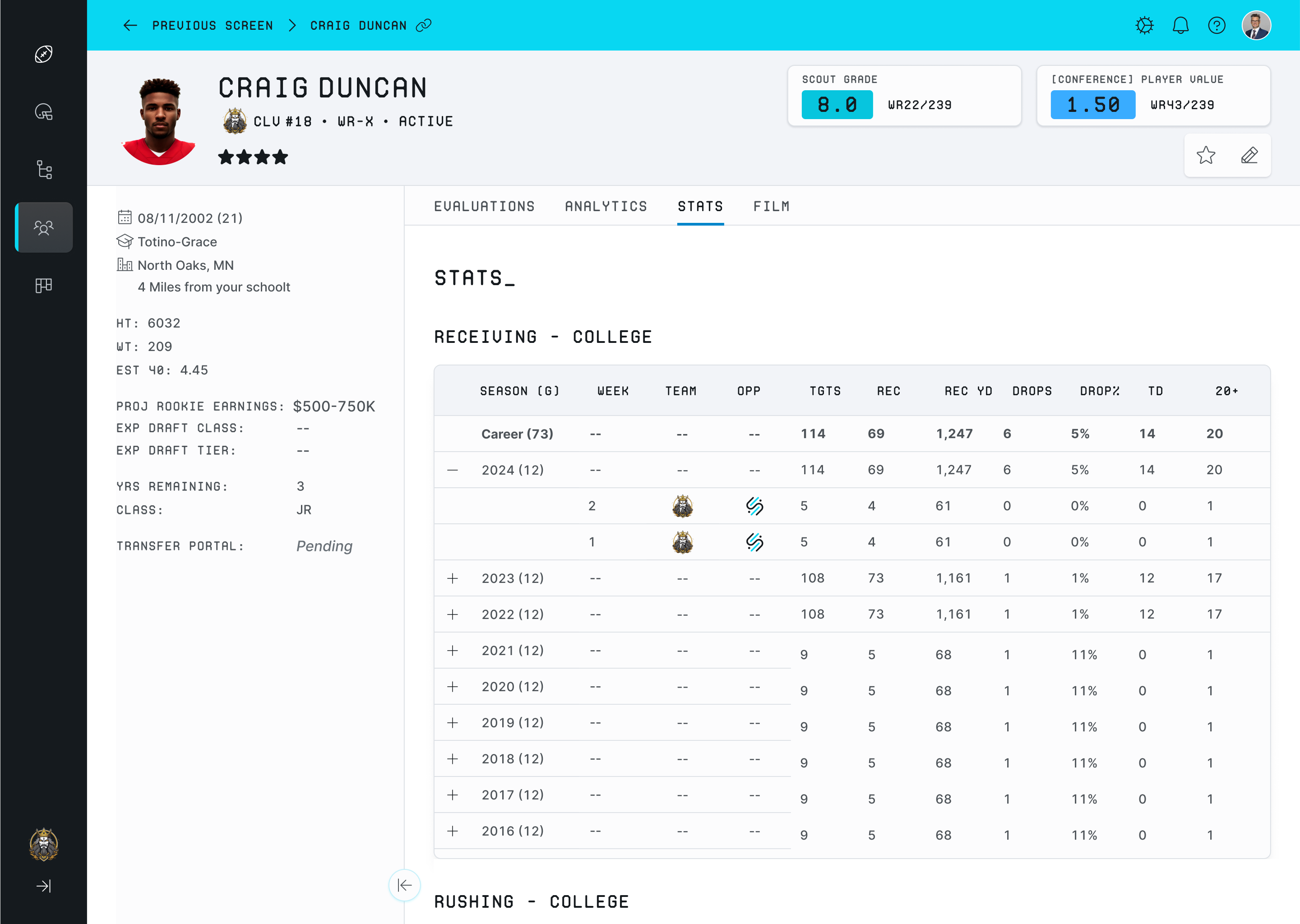
Targeting Lower Levels of Competition to Address Depth
While the winter portal may be stacked with premiere talent at the G5 level (i.e. those who led their team in targets) there is still an opportunity to identify G5 talent that may address a specific depth on the roster.
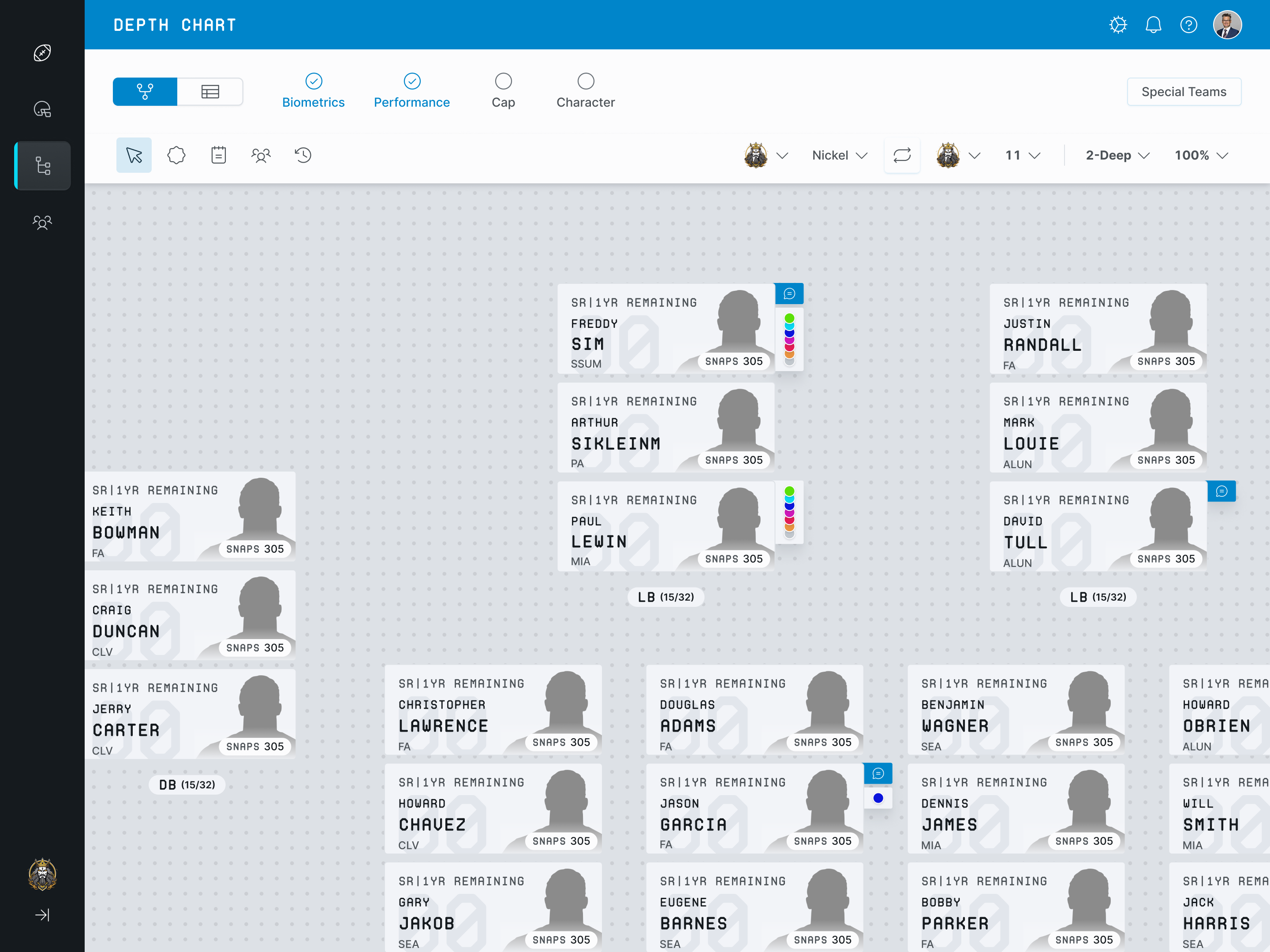
An example from this past season was Syracuse adding Justus Ross-Simmons. The #2 in target share behind Tory Horton at Colorado State, he still exemplified a speed threat for the Syracuse offense, as our on-field 40 estimate had him a 4.45 with a 6-3 frame and was a spring portal target for Syracuse this past year. Davon Booth averaged 6 yards per carry, with nearly 50% of his yards coming after contact at Utah State in 2023 (also had an on-field estimate of 4.5). He transfers to Mississippi State and provides immediate value to their running game in 2024. Emmanuel Pregnon allowed only 5 pressures in 2022 with our metrics showing him as a 99% in his first jump in pass blocking at Wyoming. He continued to show that value with 0 sacks allowed in 2 seasons at USC.
Address Phase Gaps
Given the expansion of scholarships on a roster to 105 spots, the additional 20 roster spots foster much more creativity and allows for more specific roles on the roster as well as start to plug in gaps if different phases of the team. Using the team summary can allow a team to dig into where there are analytics strengths and weaknesses and in what phase of the game. As mentioned before, any uncertainty at a specific phase post spring practice should warrant a look for rotational depth considerations. Premium positions will be a much high scarcity in the spring so addressing a phase (say run defense) may require multiple players brought into rotate to help the phase given the additional scholarship spots. Ole Miss ranked #48 in Havoc % (TFL + Pass Breakups + INTs + Force Fumble) and took a swing on a corner from University of Houston in Isaiah Hamilton, who had 61 tackles and 4 INTS who ended up as a rotational corner with 4 pass breakups on the season.
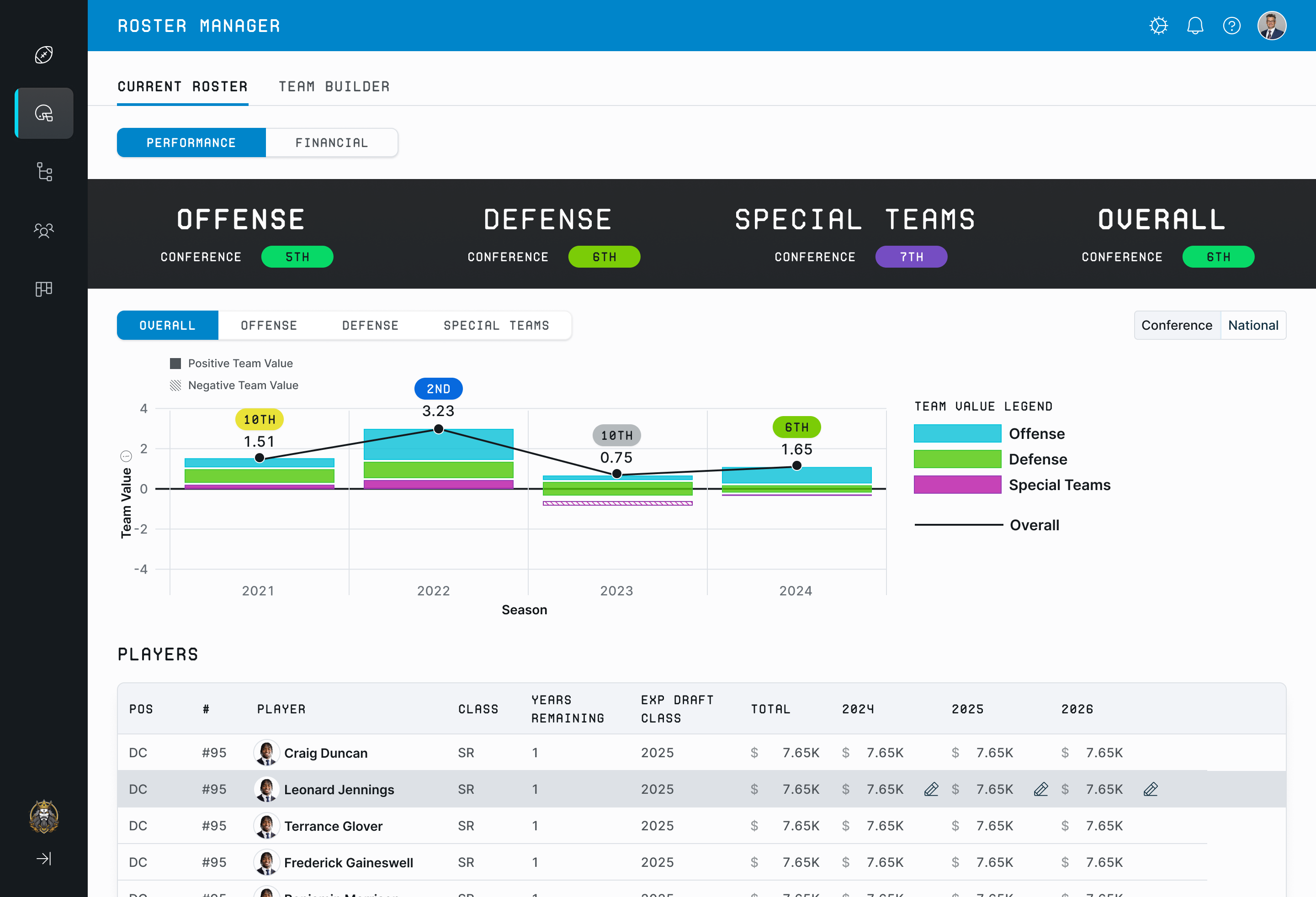
Proximity to Home
Looking for players that are from the area originally can also be a helpful strategy in convincing them to transfer to come home. Having a distance calculation of how far a player is from their home to the school can help identify some players who have performed well and would like the opportunity to perform in a setting familiar to them. This is a functionality that exists with the SumerNCAA and helps to aid schools in finding talent that is local. Quinn Ewers notable transferred back to Texas near where he grew up making the transfer more comfortable. Kingsley Suamataia transferred back home to Utah after one season with the Oregon Ducks and chose to play at BYU.
Impact Transfers for This Cycle
The following are some transfers we think could be good pickups in this cycle to provide some additional production to the depth chart given their experience.
David Bailey, EDGE (Stanford -> Texas Tech)
Bailey enters the spring transfer portal as the top prize, a versatile outside linebacker who has excelled during his three years at Stanford. Unlike most spring portal entries, Bailey is an experienced starter capable of immediately assuming a leadership role in a new defensive scheme. Over three seasons at Stanford, he has accumulated 1,295 snaps and 103 tackles. Bailey’s pass rush excellence speaks for itself, ranking in the 94th percentile for Pass Rush Getoff and the 99th percentile for Pass Rush Finish. His run defense is equally impressive, with his Pursuit Score in the 99th percentile, showcasing his all-around defensive prowess. At Texas Tech, Bailey will join a multiple-front defense under new Defensive Coordinator Sheil Wood, who gains a formidable weapon to pair with Georgia Tech transfer Romello Height. This dynamic duo will create significant challenges for opposing offenses, forcing difficult protection decisions and providing Bailey ample opportunities to continue disrupting offensive schemes.
Freddie Brock, RB (Georgia State -> Oklahoma State)
With Ollie Gordon departing for the NFL, that leaves a big void at RB for the Cowboys going into 2025 season. Brock adds another weapon for Oklahoma State bringing a good change of pace ability (on-field 4.45 40 estimate) and an above average elusiveness (ability to evade tackles). He also adds above average ability in yards created per rush. He had a productive 2024 season with Georgia State with nearly 800 yards and 8 TDs and adds receiving ability with 22 catches and 9 yards after catch per reception in a starting capacity.
Stephen Daley, EDGE (Kent State)
Daley entered the portal in early April and provides a nice depth option for P5 programs. He was a two- year starter at Kent State with multiple seasons 25+ pressures and 40+ tackles. With an estimated on-field speed of 4.6 and projected 7.32 3-cone on-field estimate, he provides rotational pass rush ability for programs looking to add more depth. He finished 2024 as a top 50 run stopper for edge in all of FBS. In games against Penn State, Pittsburgh, and Tennesse he was able to apply pressures on the QB (3 against Penn State, 4 against Pittsburg and 2 against Tennessee). He could be a quick impact player available in the transfer portal.
LJ Green, DC (Troy)
After a productive first year starting season at Troy featuring 31 tackles and 2 INTs, Green is an intriguing option for slot cornerback depth at a school with need in coverage. With an estimated on-field speed of 4.47, he is one of the top corners in the country in our SumerScore Closing metric, which grades corners on their ability to make a play on the ball when the ball is in the air. This seems like a skillset that could be used by many programs looking for rotational depth in the secondary.
Christian Fitzpatrick, WR (Marshall -> Oklahoma State)
After a breakout season in his first year starting, Fitzpatrick looks to capitalize on this season by trying to sign with a P5 school as he’s been contacted by schools such as Baylor, Colorado, Arkansas, and Louisville. At 6-4 217 lbs he provides an immediate red zone target for teams looking to add to their depth. With 35 catches on 79 targets and above average route running ability in our SumerScore metric, he could be nice value add with a P5 QB targeting him.

